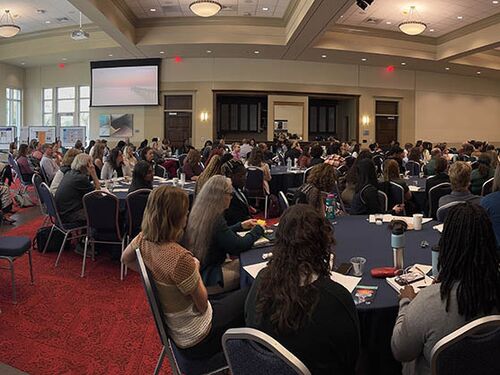To Achieve Health Equity, Leverage Nurses and Increase Funding for School and Public Health Nursing, Says New Report
News Release
By Stephanie Miceli
Last update May, 11 2021
WASHINGTON — Nursing in the next 10 years will demand a larger, more diversified workforce prepared to provide care in different settings, to address the lasting effects of COVID-19, to break down structural racism and the root causes of poor health, and to respond to future public health emergencies, says a new report from the National Academy of Medicine.
To expand access to health care during the COVID-19 pandemic, many states relaxed or waived restrictions on the care nurses may provide under their license. By 2022, all state and federal policy changes in response to the COVID-19 pandemic that expanded scope of practice should be made permanent, along with telehealth eligibility, insurance coverage, and equal payment for services provided by nurses, says the report. Local, state, and federal governments should also prioritize funding and deployment of more school and public health nurses.
Nurses represent the largest segment of the U.S. health care workforce, with nearly 4 million nationwide. Over the next decade, nurses will face many demands: caring for an aging population, responding to an increase in behavioral and mental health conditions, conducting research, and helping shape health care policy. To build a workforce that meets these needs, the U.S. needs a substantial increase in the number, types, and distribution of nurses across geographic areas, specialties, and care settings, says The Future of Nursing 2020 – 2030: Charting a Path to Achieve Health Equity. There is a particular need for nurses who hold bachelor’s and Ph.D. degrees, as well as nurses in specialties with significant shortages, including public and community health, behavioral health, primary care, long-term care, geriatrics, school health, and maternal health.
Under full practice authority — currently permitted in 23 states and D.C. — nurses can prescribe medication, diagnose patients, and manage treatments without a physician present. In these states, quality of care has improved and so has access to primary care, especially as the U.S. contends with an ongoing pandemic and physician shortages. While there has been considerable progress in lifting scope of practice regulations, 27 states still do not allow full practice authority for nurse practitioners. Federal authority should be used where available to supersede restrictive state laws, including those addressing scope of practice, the report says.
“This is a transformational time for the field of nursing. While the pandemic has changed nearly every aspect of health care, the impacts on nursing may be the most profound, as demand for their skills is at an all-time high,” said Mary Wakefield, visiting professor at Georgetown University and at the University of Texas at Austin, and co-chair of the committee that wrote the report. “Policymakers and health system leaders must seize this moment to strengthen nurse education and training, integrate health equity into nursing practice, and protect nurses’ physical, emotional, and mental well-being, so they can provide the best care possible.”
Nurses already play a significant role in addressing social needs and the social determinants of health (SODH), which are the non-medical factors that influence health outcomes — including access to health care, job conditions, neighborhood and physical environment, housing stability, and transportation. Government agencies, health care and public health organizations, and payers should ensure nurses have the resources and support to address SDOH in a more comprehensive way, and that payment models recognize the value of those services and offer adequate reimbursement, the report says. By the end of 2021, all national nursing organizations — led by the Tri-Council for Nursing and the Council of Public Health Nursing Organizations — should begin to develop a shared agenda for addressing SDOH and achieving health equity, the report adds.
“Nurses are often the first to check if patients have enough to eat, if they can afford their medications, whether they need housing assistance, and if they have reliable internet access for telehealth visits. When we invest in nurses, more people and communities will have the opportunity to live their healthiest lives,” said David Williams, co-chair of the committee, professor of public health and chair of the department of social and behavioral sciences at Harvard’s T.H. Chan School of Public Health, and professor, department of African and African American studies at Harvard University. “Nurses interact with all facets of society, from health care, to education, public health, and every level of government. They have a crucial role in charting our country’s course for good health and well-being for all.”
The report identified a number of priorities to meet the needs of the U.S. population and the nursing profession for the next decade.
Strengthening Nursing Education: Future nurses need to be ready to address SDOH and promote health equity, regardless of their level of education and their work setting. Historically, nursing education programs have emphasized training for hospital-based care, rather than community settings, schools, workplaces, and home health care. Schools of nursing should increase coursework and learning experiences in these community settings, in primary care, and in Federally Qualified Health Centers, Rural Health Clinics, and Indian Health Service sites. Nursing education should also prepare students to adapt to new technologies, particularly telehealth and the application of big data.
Promoting Diversity, Inclusivity, and Equity in Nursing Education and the Workforce: Currently, nursing program faculty are overwhelmingly white and female. Nursing students and faculty not only need to reflect the diversity of the U.S. population but also need to help dismantle structural racism prevalent in education and the workforce. Schools of nursing should improve recruitment, hiring, and advancement of diverse faculty with expertise in SDOH; support nurse leaders in mentoring and sponsoring nurses from underrepresented communities; and identify students who may need financial assistance early in the recruitment and admission process. Nursing education programs should also expand remote learning and build partnerships with community and tribal colleges.
Investing in School and Public Health Nurses: For some students, a school nurse may be the only health professional they see regularly. However, about 25 percent of schools do not employ a school nurse, and school nursing remains underfunded, especially in schools serving children in low-income homes. State and local governments should apportion more general funds for school nursing, or identify other dedicated revenue streams, the report says.
Protecting Nurses’ Health and Well-Being: COVID-19 and incidents of hate and discrimination, particularly against nurses of Asian descent, further intensified burnout and left nurses feeling unprotected, the report says. Employers should prioritize improving nurse well-being and hold leadership accountable for making necessary changes to workplace culture, environment, and policies. As more nurses are expected to address both health and social justice issues, they will have to take on more emotionally taxing work, and employers need to provide adequate space and support, the report urges. Further, nurses from underrepresented groups have reported facing a “diversity tax,” being asked to serve on diversity and inclusion committees and participate in other activities that are uncompensated, unacknowledged, and unrewarded. These demands can lead to burnout and frustration. Equity and antiracism initiatives should not be treated as separate from everyday activities and responsibilities, but embedded into every aspect of nursing.
Preparing Nurses for Disaster and Public Health Emergency Response: Nurses have been reliable, proven responders during public health emergencies, including the ongoing COVID-19 pandemic; climate disasters; and in the aftermath of gun violence. However, fundamental reforms are needed in nursing education, practice, and policy, so nurses can better protect and care for recovering populations. The Centers for Disease Control and Prevention should fund a National Center for Disaster Nursing and Public Health Emergency Response, along with regional centers, to provide relevant education, training, and career development. Licensing examinations should also expand content to cover the responsibilities of nurses in disaster and public health emergency response.
Increasing the Number of Ph.D.-Prepared Nurses: More Ph.D.-prepared nurses are needed to conduct research and serve as faculty to educate the next generation of nurses. Additionally, having more nurses prepared at the Ph.D. level who focus on the connection among SDOH, health disparities, and health equity will help build a knowledge base for other nurses to translate to practice. One approach for increasing the number of Ph.D.-prepared nurses is for foundations to fund programs focused on building the Ph.D. pipeline.
“Nurses are powerful in number and in voice, and the world needs their dedication and persistence more than ever. The pandemic has taught us that health care organizations will be made stronger when nurses’ knowledge, skills, and contributions are valued and appreciated, and when nurses are given the tools, resources, and institutional support to do their jobs in the best way possible,” said Victor Dzau, president of the National Academy of Medicine. “I am confident that the nursing community and other important stakeholders will use the report recommendations to unleash the power of nurses and usher in a new era of health equity and well-being.”
The report also contains a supplemental statement by one committee member, which suggests additional observations and recommendations related to the impact of COVID-19 on nursing, among other topics. In a response to the supplemental statement, the committee noted that it believes the findings and conclusions that form the basis for its recommendations are consistent with the current evidence.
The study — undertaken by the Committee on the Future of Nursing 2020 - 2030 — was sponsored by the Robert Wood Johnson Foundation. The National Academies of Sciences, Engineering, and Medicine are private, nonprofit institutions that provide independent, objective analysis and advice to the nation to solve complex problems and inform public policy decisions related to science, technology, and medicine. They operate under an 1863 congressional charter to the National Academy of Sciences, signed by President Lincoln.
Contact:
Stephanie Miceli, Media Relations Officer
Office of News and Public Information
202-334-2138; e-mail news@nas.edu
Featured Publication
Consensus
·2021
The decade ahead will test the nation's nearly 4 million nurses in new and complex ways. Nurses live and work at the intersection of health, education, and communities. Nurses work in a wide array of settings and practice at a range of professional levels. They are often the first and most frequent...
View details



